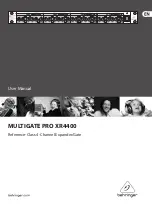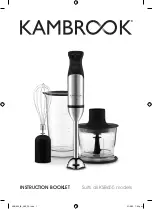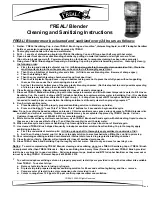
13
MULTIGATE PRO XR4400 User Manual
6.3 Applications
6.3.1 Suppressing crosstalk in multi-track applications
One of the most frequent applications of an expander/gate is the elimination
of unwanted crosstalk between single channels during recording or playback.
In particular, when recording acoustic drum sounds, this type of application is
frequently used, because here several microphones closely positioned next to
each other are used.
The high sound pressure levels of the individual instruments lead to crosstalk
in adjacent microphones. Frequency cancellations and a non-defined sound
(“comb filter” effect) are the result. It has proven wise to use a separate
microphone for each drum instrument and to “gate” each microphone channel.
Insert the BEHRINGER MULTIGATE PRO into the recording channel of the snare
drum, for example, and adjust the device so that it responds only to hits on the
snare drum. Each single microphone should be optimally positioned before,
and the threshold of the respective channel should be set so that the drum sound
can be separated cleanly, just as if the instrument were played alone.
6.3.2 Reducing crosstalk in stage microphones
The MULTIGATE PRO can be used in a variety of live/stage and multimicrophone
applications: a moderately set expander can effectively suppress background
noise, or the noise build-up that is typically produced by compressors as well
as crosstalk between microphones, etc. without causing other unwanted
side effects.
Typically, an expander can be used to process vocal tracks. Particularly when
using a compressor, the distance between singer and microphone is of crucial
importance: As the distance increases, more and more disturbing background
noise is picked up. You should therefore use the expander function to fade out
unwanted interference noise “inaudibly” during signal pauses.
In live situations you can eliminate bleeding, for instance, from drum to piano
tracks, or clean your recordings from other acoustic “pollution”.
If you do not have enough microphones (or MULTIGATE PRO!) to record each
instrument separately, try forming so-called subgroups: comprise the snare and
middle toms, side toms, kick drum and cymbals in one group using the subgroup
facilities on your mixing console.
The goal is to position the group’s microphones and to adjust the expander
so that with each hit on a specific instrument only one microphone opens,
thus transmitting only one specific instrument, while the remaining microphones
remain muted.
6.3.3 Reducing feedback in stage microphones
As soon as a singer sings into his/her microphone, background noise is masked
and thus not perceived. During signal pauses, however, the microphone picks
up the noise from PA and monitor speakers, which can lead to torturing feedback.
By inserting the MULTIGATE PRO into the vocal channel and by adjusting it to
mute the microphone when it is not in use, you can reduce the risk of feedback in
this particular channel.
Basically, this configuration should be used for all stage microphones.
7. Specifications
Audio Input
Connectors
XLR and 1/4" jack
Type
RF filtered, servo-balanced input
Impedance
50 kOhm balanced, 25 kOhm
unbalanced
Max. Input Level
+21 dBu balanced and unbalanced
CMRR
typ. 40 dB, >55 dB @ 1 kHz
Audio Output
Connectors
XLR and 1/4" jack
Type
Electronically servo-balanced output
stage
Impedance
60 Ohms balanced, 30 Ohm unbalanced
Max. Output Level
+21 dBu, +20 dBm balanced and
unbalanced
System Specifications
Frequency Response
18 Hz to 30 kHz, +/- 3 dB
Noise
>95 dBu, unweighted, 22 Hz to 22 kHz
THD
0.008% typ. @ +4 dBu, 1 kHz, Gain 1
IMD
0.01% typ. SMPTE
Crosstalk
<-100 dB, 22 Hz to 22 kHz
Gate Section
Type
UTR (Ultra Transient Response) gate
Threshold
variable (BYPASS to +10 dBu)
Attack
program dependent
Hold
variable (0 to 4 sec)
Release
variable (50 ms to 4 sec)
Range
variable (0 to -80 dB)
Expander Section
Type
IRC (Interactive Ratio Control) expander
Attack
program dependent
Ratio
variable (1:1 to 1:4)
Side-Chain Filter
Frequency
variable (100 Hz to 10 kHz)
BW (Bandwidth)
variable (2.3 to 0.7 oct.)

































